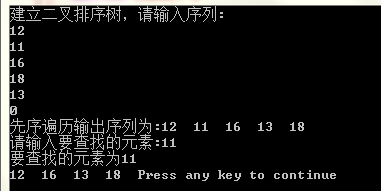1.二叉排序树的定义与描述
二叉排序树又称为二叉查找树,它是一种特殊的二叉树。
定义:二叉排序树是一颗空树或者是具有一下性质的二叉树。
1)若它的左子树非空,则左子树上所有的结点值均小于根结点的值。
2)若它的右子树非空,则右子树上所有的结点的值均大于(或等于)根结点的值。
3)它的左右子树也分别是二叉排序树。
2.数据结构
typedef struct node
{
KeyType key ; /*关键字的值*/
struct node *lchild,*rchild;/*左右指针*/
}BSTNode, *BSTree;3.二叉排序树的创建
可以将树结点逐个插入到二叉排序树(一开始可以是一颗空树)中,只要保证插入后,依然满足二叉排序树的特点,就可以创建一个二叉排序树。
设树结点的关键字值为key
算法思想:
1)若二叉排序树是空树,则将key结点成为二叉排序树的根结点。
2)若二叉排序树非空树,则将key与二叉排序树的根进行比较:
a.如果key的值等于根结点的值,则停止插入。
b.如果key的值小于根结点的值,则将key所在结点插入左子树。
c.如果key的值大于根结点的值,则将key所在结点插入右子树。
算法实现:
void InsertBST(BSTree *bst, KeyType key)
/*若在二叉排序树中不存在关键字等于key的元素,插入该元素*/
{
BSTree s;
if (*bst == NULL)/*递归结束条件*/
{
s=(BSTree)malloc(sizeof(BSTNode));/*申请新的结点s*/
s-> key=key;
s->lchild=NULL;
s->rchild=NULL;
*bst=s;
}
else {
if (key < (*bst)->key)
InsertBST(&((*bst)->lchild), key);/*将s插入左子树*/
else
if (key > (*bst)->key)
InsertBST(&((*bst)->rchild), key); /*将s插入右子树*/
}
}4.二叉排序树的查找
因为二叉排序树是可以看作是一个有序表,所以其查找过程和折半查找类似。
算法思想:
首先将待查关键字key与根节点关键字t进行比较:
a.如果key = t, 则返回根节点指针。
b.如果key < t,则进一步查找左子书。
c.如果key > t,则进一步查找右子树。
1)递归算法实现:
/*在根指针bst所指二叉排序树中,递归查找某关键字等于key的元素,若查找成功,返回指向该元素结点指针,否则返回空指*/
BSTree SearchBST(BSTree bst, KeyType key) {
if (!bst)
return NULL;
else
if (bst->key == key)
return bst;/ *查找成功* /
else {
if (bst->key > key)
return SearchBST(bst->lchild, key); /*在左子树继续查找*/
else
return SearchBST(bst->rchild, key); /*在右子树继续查找*/
}
}2)非递归实现
BSTree SearchBST(BSTree bst, KeyType key)
/*在根指针bst所指二叉排序树bst上,查找关键字等于key的结点,若查找成功,返回指向该元素结点指针,否则返回空指针*/
{
BSTree q;
q=bst;
while(q)
{
if (q->key == key)
return q; /*查找成功*/
if (q->key > key)
q=q->lchild; /*在左子树中查找*/
else
q=q->rchild; /*在右子树中查找*/
}
return NULL; /*查找失败*/
}完整代码描述:
#include <stdio.h>
#include <stdlib.h>
#define ENDKEY 0
typedef int KeyType;
typedef struct node
{
KeyType key ; /*关键字的值*/
struct node *lchild,*rchild;/*左右指针*/
}BSTNode, *BSTree;
void InsertBST(BSTree *bst, KeyType key)
/*若在二叉排序树中不存在关键字等于key的元素,插入该元素*/
{
BSTree s;
if (*bst == NULL)/*递归结束条件*/
{
s=(BSTree)malloc(sizeof(BSTNode));/*申请新的结点s*/
s-> key=key;
s->lchild=NULL;
s->rchild=NULL;
*bst=s;
}
else
if (key < (*bst)->key)
InsertBST(&((*bst)->lchild), key);/*将s插入左子树*/
else
if (key > (*bst)->key)
InsertBST(&((*bst)->rchild), key); /*将s插入右子树*/
}
void CreateBST(BSTree *bst)
/*从键盘输入元素的值,创建相应的二叉排序树*/
{
KeyType key;
*bst=NULL;
scanf("%d", &key);
while (key!=ENDKEY) /*ENDKEY为自定义常量*/
{
InsertBST(bst, key);
scanf("%d", &key);
}
}
void PreOrder(BSTree root)
/*先序遍历二叉树, root为指向二叉树根结点的指针*/
{
if (root!=NULL)
{
printf("%d ",root->key); /*输出结点*/
PreOrder(root->lchild); /*先序遍历左子树*/
PreOrder(root->rchild); /*先序遍历右子树*/
}
}
/*
BSTree SearchBST(BSTree bst, KeyType key)
/ *在根指针bst所指二叉排序树中,递归查找某关键字等于key的元素,若查找成功,返回指向该元素结点指针,否则返回空指针* /
{
if (!bst)
return NULL;
else
if (bst->key == key)
return bst;/ *查找成功* /
else
if (bst->key > key)
return SearchBST(bst->lchild, key);/ *在左子树继续查找* /
else
return SearchBST(bst->rchild, key);/ *在右子树继续查找* /
}*/
BSTree SearchBST(BSTree bst, KeyType key)
/*在根指针bst所指二叉排序树bst上,查找关键字等于key的结点,若查找成功,返回指向该元素结点指针,否则返回空指针*/
{
BSTree q;
q=bst;
while(q)
{
if (q->key == key)
return q; /*查找成功*/
if (q->key > key)
q=q->lchild; /*在左子树中查找*/
else
q=q->rchild; /*在右子树中查找*/
}
return NULL; /*查找失败*/
}/*SearchBST*/
BSTNode * DelBST(BSTree t, KeyType k) /*在二叉排序树t中删去关键字为k的结点*/
{
BSTNode *p, *f,*s ,*q;
p=t;
f=NULL;
while(p) /*查找关键字为k的待删结点p*/
{
if(p->key==k ) break; /*找到则跳出循环*/
f=p; /*f指向p结点的双亲结点*/
if(p->key>k)
p=p->lchild;
else
p=p->rchild;
}
if(p==NULL) return t; /*若找不到,返回原来的二叉排序树*/
if(p->lchild==NULL) /*p无左子树*/
{
if(f==NULL)
t=p->rchild; /*p是原二叉排序树的根*/
else
if(f->lchild==p) /*p是f的左孩子*/
f->lchild=p->rchild ; /*将p的右子树链到f的左链上*/
else /*p是f的右孩子*/
f->rchild=p->rchild ; /*将p的右子树链到f的右链上*/
free(p); /*释放被删除的结点p*/
}
else /*p有左子树*/
{
q=p;
s=p->lchild;
while(s->rchild) /*在p的左子树中查找最右下结点*/
{
q=s;
s=s->rchild;
}
if(q==p)
q->lchild=s->lchild ; /*将s的左子树链到q上*/
else
q->rchild=s->lchild;
p->key=s->key; /*将s的值赋给p*/
free(s);
}
return t;
} /*DelBST*/
void main()
{
BSTree T;
int k;
BSTree result;
printf("建立二叉排序树,请输入序列:\n");
CreateBST(&T);
printf("先序遍历输出序列为:");
PreOrder(T);
printf("\n请输入要查找的元素:");
fflush(stdin);
scanf("%d",&k);
result = SearchBST(T,k);
if (result != NULL)
printf("要查找的元素为%d\n",result->key);
else
printf("未找到!\n");
result = DelBST(T,k);
PreOrder(result);
}运行结果图:






















 343
343











 被折叠的 条评论
为什么被折叠?
被折叠的 条评论
为什么被折叠?








